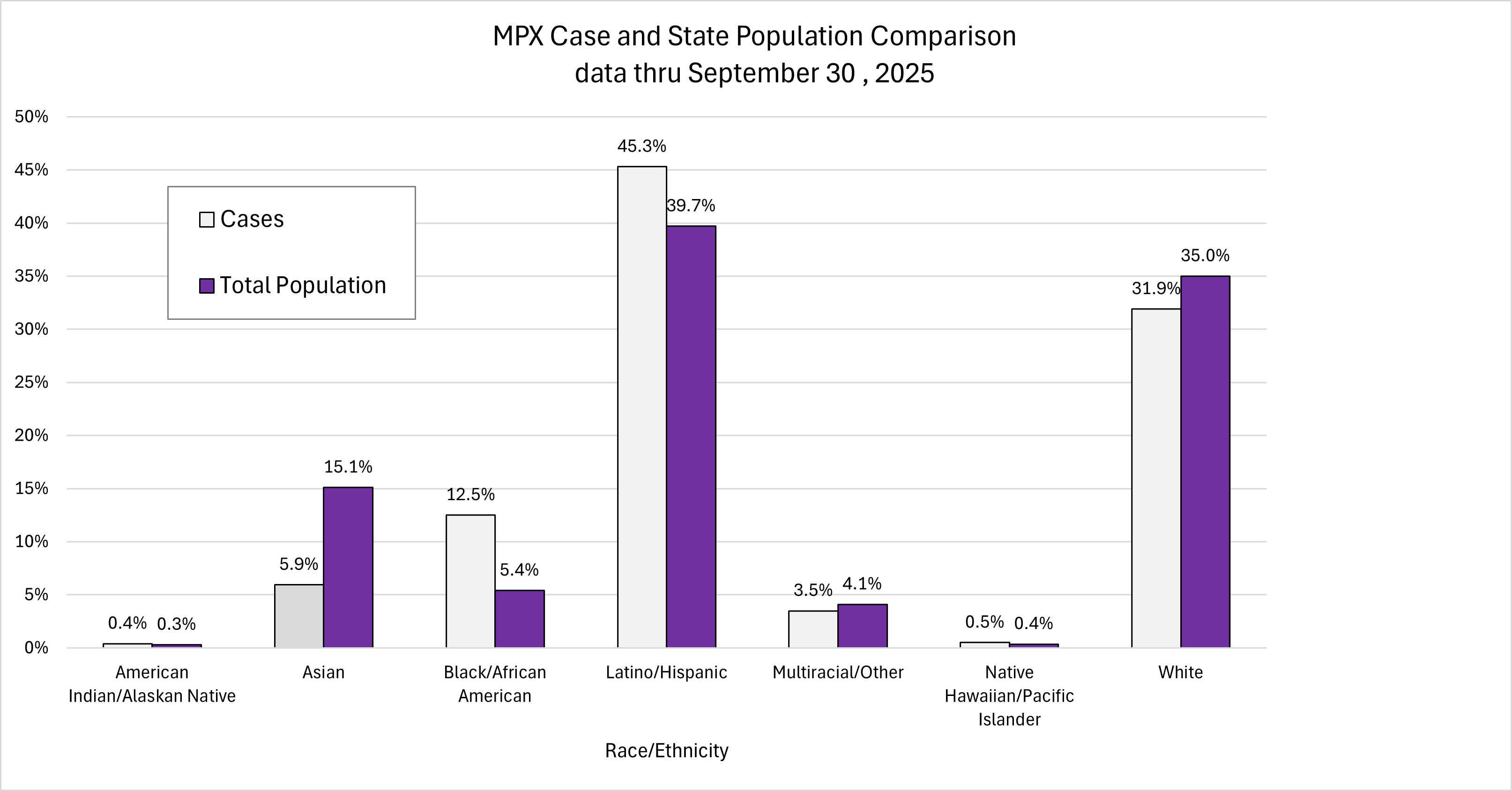How CDPH is Addressing Mpox Health Inequities
Health equity is a public health priority in California and is central to the state’s health improvement plan. The importance of health equity has been further elevated by recent outbreaks of infectious diseases. Socioeconomic components such as environment, employment and access to healthcare are now more widely recognized as elements influencing one’s health. As with the COVID-19 pandemic, inequities (including structural racism within communities) have played an important role in the mpox outbreak. Throughout the mpox response, the California Department of Public Health (CDPH) has recognized the existence of unequal access to and utilization of health care resources by under-resourced communities.
Reducing mpox risk in all communities is significantly important and CDPH is working to ensure that no community is left behind. Our efforts to support communities with focused interventions and outreach is working to close disparity gaps in infection rates. Our mpox response prioritizes data-driven strategies and works with disproportionately impacted and underserved communities.
CDPH has taken a community-led approach to address gaps in outcomes. This includes focused testing strategies, targeted education and messaging and vaccine distribution to affected communities through partnerships with local health departments, community-based organizations and safety net providers.
Mpox Case and State Population Comparison
Mpox is disproportionately affecting persons identifying as Black/African American or Latino/Hispanic. Latino/Hispanic persons comprise 39.7% of the California population, but 45.3% of the Mpox cases. Black/African American persons comprise 5.4% of the California population but 12.5% of the Mpox cases.

Mpox Case and Vaccine Recipient Comparison
The comparison of proportion of cases and proportion of vaccinations among racial and ethnic groups reveals a call to action to engage communities to close these gaps in care. Although 45.3% mpox cases occur in Latino/Hispanic persons, only 26.1% of vaccine recipients are Latino/Hispanic. Black/African American persons comprise 12.5% of cases but only 7.5% of persons vaccinated in California. CDPH is working to ensure that all people at risk for mpox have access to vaccine, regardless of race or ethnicity.

CDPH is identifying communities most impacted by mpox and securing resources to address mpox health inequities. CDPH will continue to use a community-based approach, by supporting and assisting local health departments and community organizations, in this process. Although much more work is required to tackle these disparities, our focus on equity has been fundamental to building a Healthy California for All.
CDPH has taken action to make sure accurate information, vaccines and supportive resources are available to California’s most vulnerable communities. Some examples of these efforts include:
Working to Reduce Stigma:
The Centers for Disease Control (CDC) defines stigma as:
discrimination against an identifiable group of people, a place, or a nation. Stigma is associated with a lack of knowledge about how a disease spreads, a need to blame someone, fears about disease and death and gossip that spreads rumors and myths.
CDPH is committed to reducing stigma in communities most impacted by mpox. Some examples of this work include:
- Outreach to disproportionately affected communities with non-alarmist, fact-based messaging about mpox. Providing communities with tools for protecting themselves and others.
- Communicating the message that ‘anyone can get mpox.’ Messages that communicate ‘only gay or bisexual men or men having sex with men are at increased risk of acquiring mpox’ only stigmatizes LGBTQ individuals, an already marginalized group. Naming specific communities may harm public health efforts. It could cause providers to miss mpox in other communities or discourage some individuals from seeking testing and treatment.
- Focused messaging about prevention strategies, symptom recognition and the treatable nature of mpox. This helps reduce fear and elevate personal agency.
- Focused messages via channels that directly reach gay, bisexual, men who have sex with men, trans women and non-binary communities, such as specific websites, dating apps, or media programs.
- Using inclusive language, such as ‘us’ and ‘we’ pronouns.
- Using ‘mpox’ when referring to monkeypox.
- Recognizing that stigma affects a community’s overall well-being and that some people may need additional support beyond medical care.
Participating in Local Meetings:
CDPH regularly participates in local meetings at the invitation of local health departments and communities. Through these meetings, CDPH aims to listen to the current needs in our local communities and use this crucial information to launch actionable prevention strategies, including policy development.
Improving Data Collection to Inform Equitable Public Health Efforts:
- As part of mpox surveillance, CDPH is collecting more
comprehensive gender identity and sexual orientation data to allow for more detailed and inclusive information on factors linked to health inequities among persons affected by mpox.
- CDPH is conducting focused analysis of a range of factors, including race, Latino origin, census tract, occupation and more, to identify inequities and inform disease control efforts.
Increased Access to the Mpox Vaccine:
- At the start of the outbreak in 2022, CDPH initiated robust vaccination efforts with local health departments and community-based organizations. Focused vaccination events continued through 2024.
- CDPH worked with federal partners to provide vaccines for events that attract populations at risk for mpox. Specifically, CDPH also worked with the U.S. Health and Human Services Agency to implement a pilot program to provide additional vaccine allocations at large events (those with more than 50,000 attendees) that attracted gay, bisexual and other men who have sex with men.
State public health leaders cannot address mpox health inequities alone. A
Healthy California for All requires partnership with the private sector, local governments and community partners at all levels. We continue working with our trusted partners to spread prevention and action messaging in historically underserved communities, to reduce stigma and to expand vaccine outreach to all. For more information on how to get the mpox vaccine visit
CDPH Vaccine page and the
CDPH Guidance page for treatment.